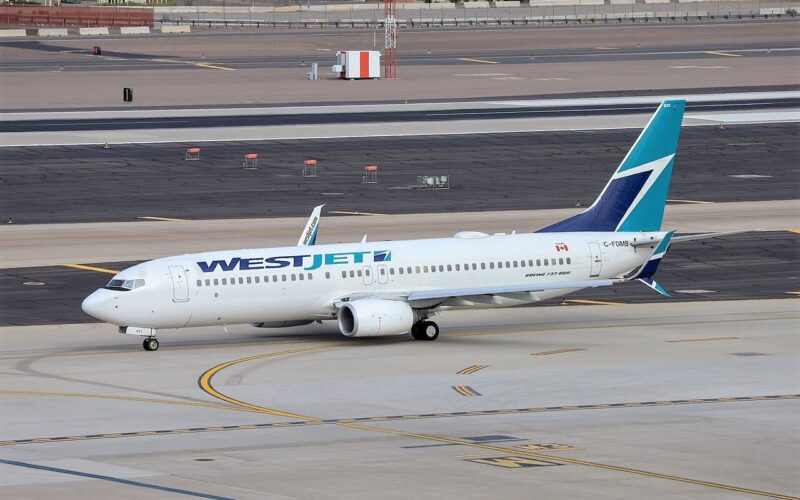The Transportation Safety Board of Canada (TSB) published an investigation report on a runway overrun incident made by the WestJet Airlines Boeing 737 aircraft flight crew.
What happened during the WestJet Boeing 737 landing?
On January 5, 2020, WestJet Boeing 737-800, registered as C-FUJR, was operating a regular domestic flight WJA248 from Toronto Lester B. Pearson International Airport (YYZ), Ontario to Halifax Stanfield International Airport (YHZ), Nova Scotia. The flight had been going smoothly until the landing at the final destination.
The flight crew of the jet, which was carrying 172 passengers and 6 crew members on board, initially planned to approach Runway 05 at YHZ airport. However, due to reduced visibility and lowering ceiling, about 14 minutes before landing pilots requested to approach Runway 14 while using their instrument landing system. After receiving approval, the jet landed on Runway 14 with a tailwind component on the wet and snow-covered runway.
Following the touchdown, the flight crew was not able to stop the aircraft and it overran the end of the runway resting in the snow with its nose wheel at about 300 feet (91 m) beyond the end of Runway 14 with no injuries or damage to the jet reported.
The aircraft tires and brakes were replaced as a precaution before the jet was returned to service.
The causes of the incident
On May 20, 2021, the TSB published the final report of the incident investigation, where the Canadian authority concluded the probable causes of the incident. The authority disclosed that while on a cruise, the pilots were preparing for their approach to Runway 05 and were reviewing the updates of weather conditions. The flight crew estimated that the length of Runway 05 was sufficient to land at.
As the jet approached the airport of destination, the flight crew received a weather information update, indicating a lower ceiling. Due to changed weather conditions, the pilots requested approval to switch Runway 05 to Runway 14 for the instrument landing system (ILS) approach. Meanwhile, the surface winds increased and caused a 15-knot tailwind component for Runway 14.
However, instead of recalculating the wind effect for the approach to Runway 14, the pilots considered that the distance of landing and the targeted approach speed, which were initially calculated for Runway 05, was still applicable for landing on another runway.
According to the report, from the time when the pilots requested the approach until touchdown on Runway 14, they were busy with reprogramming the approach and conducting the approach. The flight crew requested information on any braking action reports for Runway 14 and recognized the low visibility conditions. Besides, although it was not required, the crew completed the low-visibility approach checklist to manage the threats.
Meanwhile, after reaching lower altitudes, the jet also experienced turbulence, which further increased the workload for the Captain.
The investigators pointed out that due to a high workload, the flight crew perception was affected and the pilots continued a plan when the plan was no longer viable. In the 14 minutes period between the runway change and touchdown, the flight crew were focused on the conditions of the runway and the landing and did not recognize the changes in the wind and the tailwind component while continuing the approach.
The unchanged approach speed and the tailwind made the jet cross the threshold 10 knots faster than recommended. Due to the higher speed, the aircraft touchdown faster than expected, requiring a longer stopping distance.
The report indicated that the jet landed within the touchdown zone, and the deceleration devices, such as the speed brakes and thrust reversers, deployed as designed. After recognizing the faster speed on the rollout, the Captain of the jet also applied manual braking, which disengaged the autobrake 3 selection. Immediately upon the use of manual braking, the antiskid system activated and remained active providing the maximum deceleration available for the runway conditions.
Meanwhile, the condition of the Runway 14 surface was reported as a trace of wet snow, but the investigation could not determine the actual condition of the runway at the time. The investigators found out that the faster approach combined with the tailwind component and contaminated the runway, resulted in the runway overrun.
The Canadian authority also calculated that even if the braking action had been good to medium, the required landing distance would have still exceeded the distance available on the runway.
The authority concluded that the aircraft stopped within the runway end safety area.
WestJet takes action to prevent similar incidents
Following the incident, WestJet created a flight data monitoring (FDM) trigger to monitor landings over the maximum tailwind. The airline also sent out a Flight Safety Flash to the entire group of pilots of the Boeing 737 jet highlighting the importance of considering continually changing conditions that may impact runway surface as well as anticipated wind conditions.
The air carrier also outlined the importance of performance calculations before the intended landing on the runway and required to use one of three methods. Such methods include the aircraft communications addressing and reporting system Landing Distance Calculator, the Takeoff and Landing Report, and the Quick Reference Handbook actual landing distance table.

